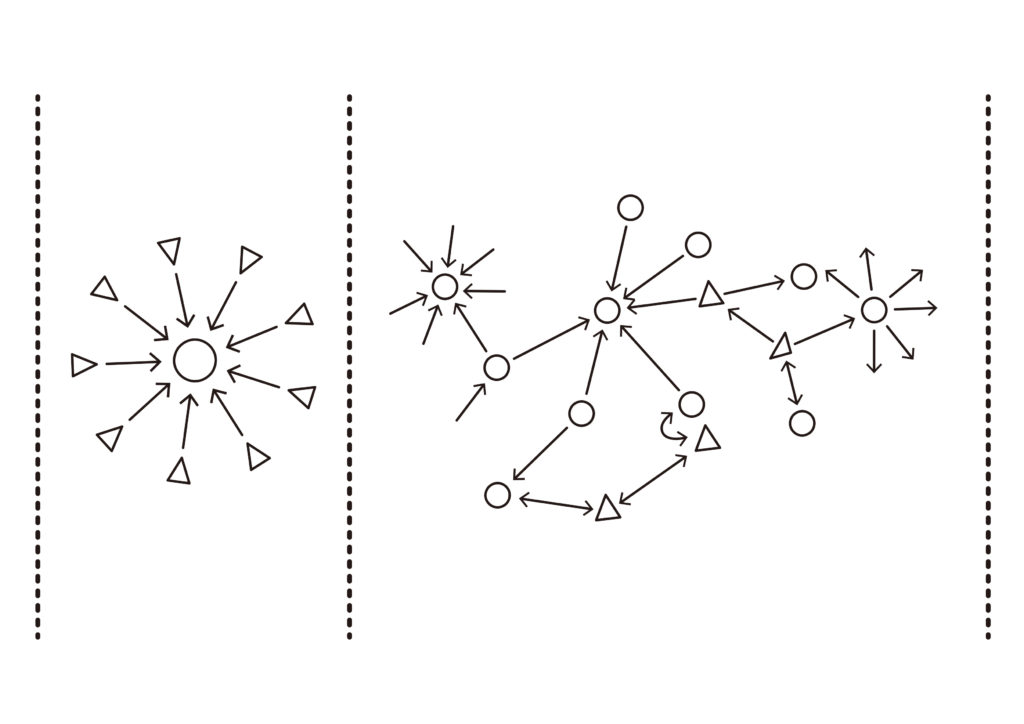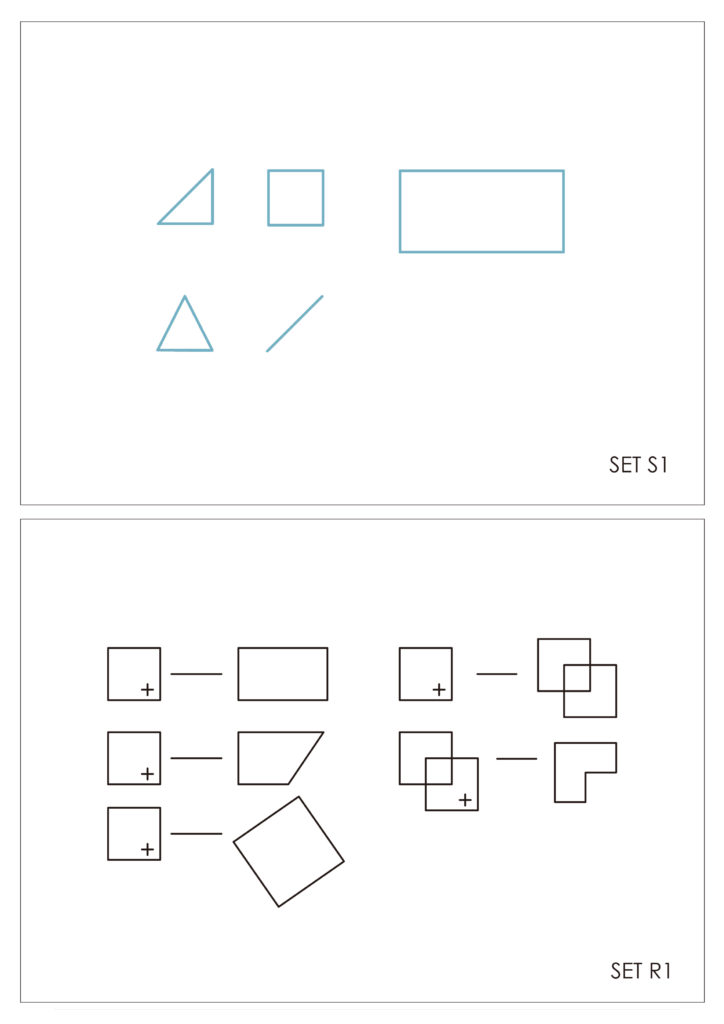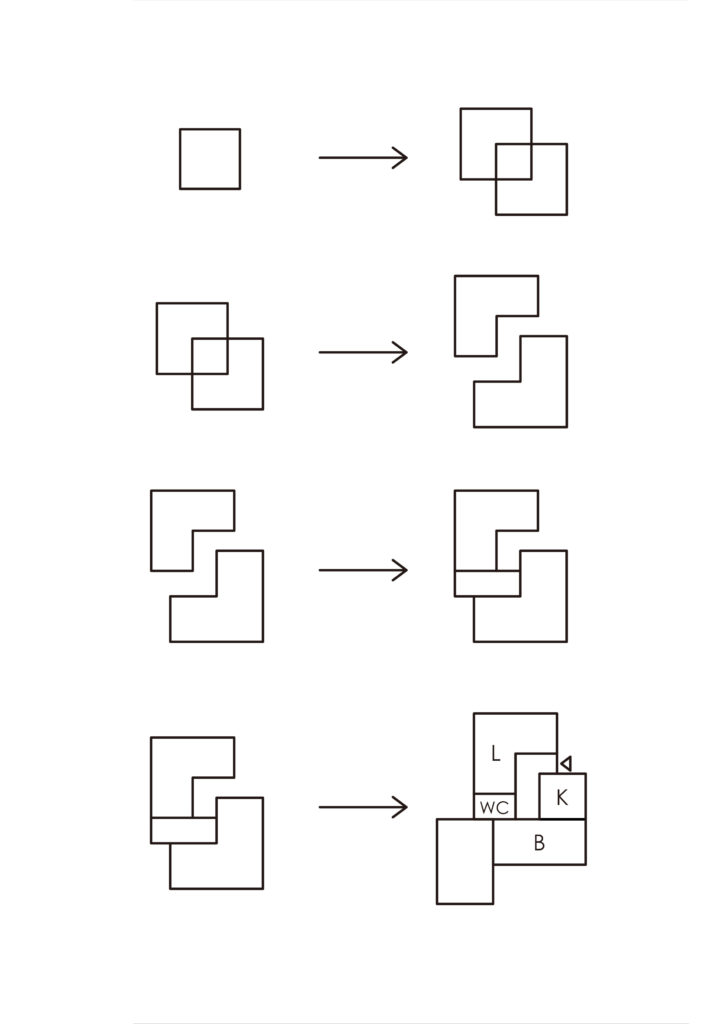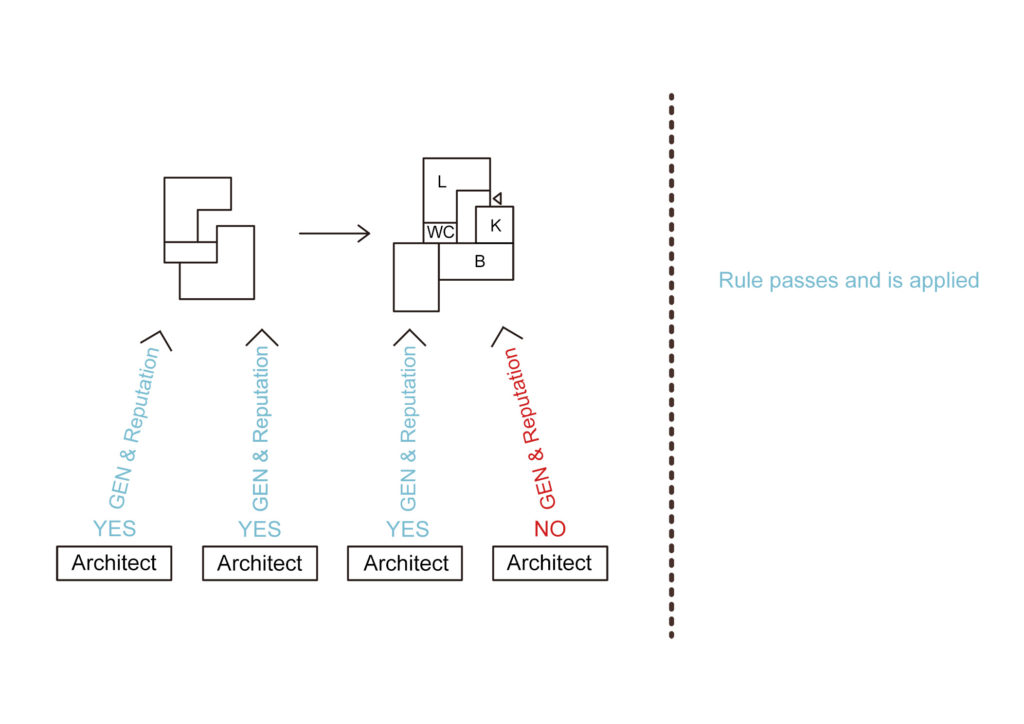The blockchain as a design platform for shape
T.Dounas, D.Lombardi
Xian Jiaotong Liverpool University
Keywords: Decentralised Autonomous Organisation, Shape Grammar, Intelligent organisms, Distributed Ledger, Blockchain
Abstract
| This paper presents an application of Decentralised Autonomous Organisation (DAO) in the field of design and AEC industry. The model is applied in the realm of shape grammar proposing the possibility of allowing multiple grammarists to collaborate in the definition of a new grammar within a Blockchain environment that acts as a distributed ledger. DAOs systems and Blockchain are introduced as well as shape grammar and its fundamental rules. The collaborative nature of a DAO with the inner logic of shape grammar, which bases its principle and rules in multiple variations and combinations of simple initial shapes, brings to the problem of recording and validating changes and improvements in the design chain. For this reason, a voting system to govern the process is introduced, based on both quantitative values, i.e. |
Introduction
Motivation.
The AEC industry remains a conservative, change-resistant, and risk-averse industry compared to other industrialised industries that have incorporated a plethora of digital tools in their operation. In particular, Architects see themselves as authors of artistic works, or at least that myth is perpetuated through marketing, social media activities but also within schools of Architecture. Modern and contemporary practices are based on the effort of collectives of experts working together, even from different continents, from the early design stages till the construction of the design proposal. CAD and BIM files are shared and updated constantly with the introduction of solutions addressing all the possible issues that a building can face. This new working style that killed the previous concept of the architect as the sole genius who supervises the entire process brought the problem of dealing with the authorship and the responsibility of who takes decisions and makes changes in the project.
In team collaboration, the model that has been identified as dominant in the past two decades is the BIM, a centralised Building Information Model shared by all where each discipline shares and inputs their own information. However, the manner in which this takes place has not been investigated extensively. Is the model orchestrated by a single authority? Are the disciplines and their experts deciding according to their own interests or for the interests of their clients? What kind of mechanisms are there to ensure the Building Information model and the architectural study are developed in a competent, transparent, complete and collaborative manner?
Conversely, the present paper presents a radical approach to collaboration and collective authorship by proposing a decentralised model of decision making, by running a shape grammar on a smart contract and digital ledger mechanism. Due to the constraints of the length of paper at present, we present the working model, leaving testing and validation in a further paper. Still, the present paper describes in detail the experimental and implementation set up and describes validation criteria.
Context and frameworks: Blockchain(s) in the built environment
A Blockchain is a digital Distributed Ledger Technology (DLT) that records transactions, encrypting the difference between each transaction in a block of information and embedding the cryptographic #hash into the next block, forming a chain of blocks with encrypted hashes, hence the term Blockchain. Common applications for Blockchains are cryptocurrencies such as Bitcoin and Ethereum, where the blockchain information is distributed amongst participants, with each node verifying transactions that take place on the network, hence cancelling the need for a central authority that verifies the validity of information. Li et al [Li 2018] describe an extensive technical, political and social framework for the application of Blockchain technologies in the construction sector. Belle [Belle 2018] also describes organisational models of Blockchain in the built environment and the impact they will have in whole countries such as China. Earlier work by the authors have already described a technical implementation framework of connecting Computer Aided Design applications with the Blockchain [Dounas, Lombardi 2018]. Within the same publication we describe the four levels of integration that are possible between a Blockchain and a CAD system, taking advantage of the immutability, transparency and distributed nature of the blockchain.
Background
Distributed ledger technologies and specifically Blockchain are distributed databases. They have a unique way of establishing consensus on which operation & transaction on a network is true and which one is not when comparing distributed sets of data. Compared with querying a central database directly, a Blockchain is distributed in various computer nodes over the network. Due to the distributed nature of the database, computational mechanisms had to be developed that would synchronise all nodes of the database with a single version of the truth. The main mechanisms with which nodes establish the truth between them are proof of work and proof of stake. Both of the mechanisms create a new block on the Blockchain, validating one operation.
In mechanisms where proof of work is employed, nodes on the network compete between them to solve a complex mathematical equation that proves the creation of a new block, thus validating an operation. As such to have any kind of monetary reward for validating a block, a node not only needs to be fast but also first with the correct result of the computation. In proof of stake the nodes and the transaction/operation use other parameters that are designed to build trust. These are the duration of how long a node has participated in the network and the amount of transactions that one has verified. As such one would trust their validation of a new block since a trustworthy node would hold a vast number of validated blocks within their record. Ethereum and Bitcoin currently use proof of work, thus having a geometrically increasing computational problem to solve, while Ethereum has designed a system to transition to proof of stake mechanism, once the proof of work mechanism becomes energy and computationally expensive.
Ethereum and its network have introduced the concept of the smart contract as a use for Blockchains beyond currencies. Within this, a transaction does not have to only be monetary but simply the execution of a computer code when certain conditions are met. In the Ethereum network, one can then build smart agencies by using smart contracts, i.e. organisations that are governed and their behaviour determined by smart contracts. Smart agencies, given enough of participants and complexities can be determined to be thus Decentralised Autonomous Organisations. In a DAO there is no board of directors or governors and all decisions are taken and operated on the infrastructure of networks similar to a decentralised distributed[MOU1] one.
Methodology
We have used a combination of qualitative research and experimentation, with the explicit goal of building a working prototype. Within the constraints of the paper we describe the algebraic [MOU2] theoretical model for the DAO grammars, and the process for creating the Blockchain infrastructure on the Ethereum network.
Implementation
Decentralised Autonomous Organisations D.A.O
All infrastructure projects in the area of DAOs (daostack.io) describe in their whitepapers the imbalance of growth and attention that takes place in a growing organisation. Within this framework the internet is essentially an infrastructure that allows peer-to-peer exchange of information. In parallel, a Blockchain network can be conceptualised as a peer-to peer infrastructure for value, as Blockchain solves the trust problem and the ownership of digital assets in online transactions. Essentially, as a facsimile a DAO resembles more an organism rather than an artificial organisation.
DAOstack.io
The DAO as presented by DAO Stack is a new organisation that operates by smart contracts on a Blockchain, i.e. decisions are taken and activated by the operation of smart contracts. DAOstack at the time is using the Ethereum infrastructure, even though there is a discussion on expanding the platform to other Blockchains as well, as an ultra-organisation that operates across various distributed ledgers.
Governance mechanism
For each decision taken in an organisation one can set up smart contracts that execute code once an event takes place, but also, they can use smart contracts to govern the organisation’s decision in a democratic manner. Instead of assigning one vote to each agent, the DAO uses ‘Gen tockens ‘and each agent’s reputation in the organisation. Each agent in the DAO has a set number of GEN tokens that they can vote with but also a set amount of reputation/influence that they can stake in a vote. As such when a vote takes place, Gen tokens act as votes but reputation/influence of the voting agents come into play.
Topology of Agents
There two manners in which agents within a DAO can be topologically distributed, either in Assembly mode, which equates more or less with a central organisation model or in a Fractal Federal governance where each agent has their own sub-assembly mode, potentially in a recurring scale, with each subassembly having N subassemblies.
Figure 1.

Within a decentralised autonomous organisation, one can of course, as in any organisation have competition between the agents that participate. If structured with current economic models, then the non-cooperative Nash equilibrium applies in their competition, i.e. some of the agents will behave in a competitive manner to strike a local win for them, but not one for the whole organisation. This forms the key question on how a DAO will steer towards good decision making, bottom-up avoiding both the pitfall of a non-cooperative Nash equilibrium, and also be resilient, i.e. allow sharing of voting power, instead of concentrating voting power to the agents with the most tokens. The first structural idea for DAOs is then the incentivising and reward of open shareable resources [DAOstack whitepaper] that lead to more growth and more openness, replacing essentially organisation that operate within non-cooperative Nash equilibriums.
Returning to the voting power with GEN tokens and reputation: within DAOstack one can transfer GEN tokens, but one cannot transfer reputation. The DAO white paper mentions: “Reputation is used here interchangeably with influence power, and can form the basis for a meritocratic governance system, where those who are most appreciated — due to their past contributions — have the most influence.” One way to award reputation is through proposals. For example, within a shape grammar making organisation there could be a proposal to award 100 SG tokens to Shape Grammarist George Stiny for his contribution to the field. Reputation can also be algorithmically computed by considering research publications on shape grammars, citations and other research impact indexes. The difference here is that a shape grammarist would translate their research impact and influence H-Index and/or C-Index into decision making power within a larger organisation, say one consisting of all shape grammarists in the world.
Essentially by using the GEN tokens and the reputation system, DAOstack builds a system where voting of an elect minority aligns with the interests of the grander majority, and ensures that the system is transparent, resilient –since even the transfer of all gen tokens to one agent will not dissuade reputation voting power but also reputation guarantees that certain propositions will always receive the attention of the community, and scalable, since through the Ethereum Blockchain anyone can participate in it. The situation where a minority makes an ‘edge’ decision’, as long as it is in line with the consensus, is called by DAOstack : ’ Holographic Consensus’ as a reference to holograms where each sliver of the three dimensional image reflects and contains the information for the whole picture.
Shape Grammars and Shape Grammarists
A shape grammar consists of a set of initial shapes S1, and a set of rules R1 that when chosen and applied to the set S1 they produce other shapes on the right-hand side of the rule. It also includes a shape rule K that is the final shape rule, that once activated, will halt computation. In essence it is a productive system, a generative system for design.
A U22 Shape Grammar in algebraic format
S1= a1, b2, c3, …. ,xn / where the shapes are of i=2 dimensions
R1=r1, r2, r3, …., rn / where the rules are of j=2 dimensions
In most of the shape grammar

We will describe here briefly the process with which an apartment grammar is created and applied- with the implication that the grammarist receives the grammar ready for operations.
Shape Set S1,(a1, b2, c3) Rule Set R1, (r1, r2, r3), the grammarist selects shape a1, and rule r1, and applies it, shape a moves 1 m to the right. In similar case shape b2 is selected, and is rotated 45 degrees with rule r2. Shape c3 is selected and is scaled twice the size with rule r3. Then another rule labels the spaces created. Once the spaces are labelled and checked against a programme [Duarte, 2005] then the grammar gets terminated. After N applications of the rules, the grammar gets terminated with the recognition of shape K.
Algebraically this is noted as:
r1: a1 -> a1’
r2: b2 -> b2’
r3: c3 -> c3’
…
rn-1: K’ -> K
rn: halt

Within this application of the grammar there are N possibilities for changing the rules, in the in between steps. We can define a set Gx of Shape Grammarists that participate in a DAO with the common goal to create an apartment grammar that creates the most variations with the most compact apartment layouts possible, by using a proportion of the global integration number (where integration is defined as the distance from a space of origin to all other spaces in the system, run for each space in the system, hence its globalism) to the floor area. The lowest fraction indicates a more compact apartment. To ensure liveable spaces, minimum sizes for the shapes in set S1 can be used, to ensure that the apartment plans produced are both mathematically compact but also provide a minimum of architectural quality. What are the possibilities that these shape grammarists have for collaboration over the internet with a record of all steps taken? How does one negotiate which of the rules is selected for application? Algebraically we have still the S1, R1 sets with the set of Gx of shape grammarists added, plus the validation criteria for the apartment:
S1, R1, Gx, and V= Global Integration / Floor Area, with S1 constraint with minimum dimensions for some of its constituents
Lets suppose that within the set Gx there are 5 experienced shape grammarists, Duarte, Stiny, Knight, Economou, Stuffs and 883 junior shape grammarists with the intention of collaboratively creating the apartment grammar that creates the most variations with the most compact apartment possible? While one needs the experienced shape grammarists F,E,D, K, S to guide the Set Gx one also needs innovative ideas from all of the constituents of the set. How does one address the whole group without creating the need to create a lot of traffic, i.e 888 emails for each step?
Gx: F,E,D,K,S,…., G883
Combining Blockchain with Shape Grammars: Operating model
Thus we propose the creation of a Blockchain grammar, the first shape grammar engine run on the DAO. We define the Blockchain grammar as the human-machine cooperation on the DAO stack, i.e. the collaboration between shape grammarists using the smart contracts that constitute the computation engine of the Blockchain grammar. The Blockchain grammar has these functionalities: Tokens distribution, where tokens get distributed to each of the 888 shape grammarists, Reputation Assignment, which assigns reputation according to research experience and impact, collective data curation, which is the creation and application of the shape grammar, and governance upgrade, where the mechanisms with which the Blockchain Grammar operates change and get upgraded to the next version. Within the reputation assignment contingent, there is a halftime calculator parameter of which can be decided by the Blockchain grammar itself. Indicatively we mention that the reputation a person has will dissipate over time if the academic does not publish, or their work does not get a citation or other reference over a specified amount of time. We propose that the initial set of shape grammarists all have the same amount of tokens, however their reputation score should be determined by the number of papers they have authored within the shape grammar paradigm, and their H-Index as calculated for their papers in the shape grammar paradigm. The formulae for initial token and reputation distribution are given below [Stallings]: 1 Shape grammarist: T tokens plus N (number of papers) + H-Index (as calculated for their papers in the shape grammar paradigm) + C-Index (as calculated for their papers in the shape grammar paradigm)
We thus can define the voting power of each member as Vt=T+N+Hi+Ci
Running a Grammar as a dAPP
The set Gx of 888 shape
| Implementation | BlockchainGrammars (alchemy) |
| Operating system | DAOstack.io |
| Infrastructure | Ethereum Network & Blockchain |
Table 1: DAOstack layers: ARC and Alchemy
The Blockchain Grammars operations Model
At each step, each shape grammarist, whether experienced or not, reads the state of the grammar, and has the right to propose the next rule(s) to be applied. Suppose that 30 proposals are submitted to the DAO. Then each of the grammarists has the potential to vote which of these rule set will be applied next, and then votes using GEN and reputation. The expectation is that the 5 senior grammarists will have their vote carry more reputation, due to their experience. At the same time though one can see that innovative solutions that have results might get voted through, as any of the 888 members will be able to propose efficient solutions. An interesting scenario of course is the voting of a proposal by a minority, say the grammarists K, S. Mathematically if all GEN tokens are the same for each of the 888 grammarists a proposal with the backing of only two members should not pass. However, if the reputation of K & S weights above the other 886 members of the DAO the proposal shall pass, and given their potential high reputation and track record, it will have a good impact on the application of the grammar.

Turing Complete: Shape grammars and Smart contracts
Within the Blockchain Grammar running on DAOstack a smart contract calculates how compact an apartment is and awards GEN and reputation to the shape grammarists that proposed the rule that produced it, but also proportionally to the shape grammarists that voted for the rule.
As such internally the DAO grammar can work algebraically: each shape grammar rule is encapsulated into the algorithm of a smart contract and as such when the rule is about to be applied the smart contract get applied. This of course raises the question of shape recognition within the shape grammar. Since we do not yet have a reliable shape recognition engine, the DAO delegates this task to the human part of the organization, a shape grammarist who will encode the new shape into a new parameter in a smart contract. Table 2
| Shape in S1 | Algebraic Parameter inside a smart contract |
| Rule in R1 | Smart Contract |
| Voting process | Smart Contract on DAOstack.io |
| Reputation award | Smart Contract |
| Validation of Shape Grammar | Smart Contract |
| Shape recognition | Shape Grammarist |
Table 2: Shape Grammar and BlockchainGrammar mechanisms correspondence.
Discussion
We have presented a model for massively scaled collaboration on shape grammars, presenting a mechanism that harnesses DAOs, Decentralised Autonomous Organisations on the Ethereum Blockchain. We believe that the mechanism we describe is viable as a wider collaboration feature of the AEC industry. Our mechanism has a collaborative content curation mechanism, distributes rights and decision-making power according to expertise, and due to the immutable nature of the blockchain accounts for responsibility of decisions on the organisation level. In particular the reputation allocation mechanism can lead into increasing the competitiveness of smaller, efficient AEC firms in a supply chain that might lack the capital to complete but they can compensate by biding via reputation in a public procurement process. It can lead for examples in more transparent and efficient collaboration in situations where the yet-undefined BIM level 3 is employed, or in situations where architects would like to harness the wisdom of non-experts in participatory design projects, but do not have the resources to collect every stakeholder’s opinion.
Both Shape Grammars and Solidity, the Ethereum language are Turing complete, which means that they can simulate any other Turing machine. In our case we have outlined the development of a shape grammar, with the addition of collective decision making as a model of organisation and content curation, within a smart agency, the DAOstack, which runs on smart contracts on the Ethereum Blockchain. The governing smart contract of the DAO runs essentially on ARC & Alchemy, the two libraries that make DAOstack possible. The possibility of running a collaborative shape grammar process on a ‘Universal computer’ such as the Ethereum blockchain claims to be, creates in certain aspects a contrast in the possible blockchain applications in the built environment. On one hand the Blockchain grammar will allow for the lifting of restrictions that shape grammars might have faced in the past in terms of Turing-completeness, where a human was able to compute with them in a much more thoughtful manner compared to a machine. At the same time for Blockchain grammar presents as a cybernetic intelligent organism, where there is a reciprocal reliance of humans and computing machines to execute the design. In contrast, though, the lack of absolute predictability of Turing-complete systems might wreak havoc in other aspects of the AEC industry with a particular reliance in reliability and predictability, for example, supply chains. Still, that would be an aspect to consider in our future work.
Further work
The mechanism we have developed will need to be tested with a vast amount of shape
References
References
Chase, S, and S Ahmad. 2005. ‘Grammar Transformations : Using Composite Grammars to Understand Hybridity in Design’. In Learning from the Past: A Foundation for the Future, 89–98. Vienna, Austria: CAAD Futures.
Dhillon, V. Metcalf, D. Hooper,M. 2017. ‘Blockchain enabled applications’. Apress, Orlando Florida, ISBN 978-1-4842-3080-0
Dounas, T. 2013. ‘Some Notes on the Incompleteness Theorem and Shape Grammars’. Zhang J., Sun C. (Eds) Global Design and Local Materialization. CAAD Futures 2013. Communications in Computer and Information Science, Vol 369. Springer,369.
Duarte, Jose Pinto. 2005. ‘Towards the Mass Customization of Housing: The Grammar of Siza’s Houses at Malagueira’. Environment and Planning B: Planning and Design32:347–80.
Economou, A. 2001. ‘Four Algebraic Structures in Design’. In Proceedings of the Twenty First Annual Conference of the Association for Computer-Aided Design in Architecture, 192–201. ACADIA.
Grasl, Thomas. 2012. ‘Transformational Palladians’. Environment and Planning B: Planning and Design39 (1):83–95.
Knight, T. 2003a. ‘Computing with Ambiguity’. Environment and Planning B: Planning and Design30.
Knight, T. 2003b. ‘Computing with Emergence’. Environment and Planning B: Planning and Design30.
Stallings,J. et al. 2013 “Determining scientific impact using a collaboration index.” PNAS Early Edition. D OI: 10.1073/pnas.1220184110
Stiny, George, and Lionel March. 1981a. ‘Design Machines’. Environment and Planning B: Planning and Design8 (3):245–55.
Wortmann, T. Stuffs, R. 2018. ‘Algorithmic complexity of shape grammar implementation’ Artificial Intelligence for Engineering Design, Analysis and Manufacturing, vol. 32. Special issue 2.
li et al, 2018 : Blockchain in the Construction Sector: A Socio-technical Systems Framework for the Construction Industry https://link.springer.com/chapter/10.1007/978-3-030-00220-6_7